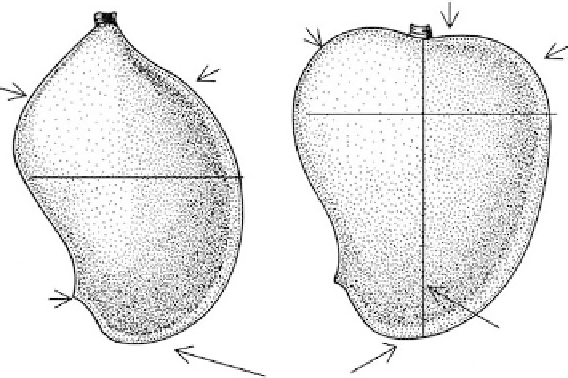Agriculture Reference
In-Depth Information
(a)
(b)
Depression
about stem
Ventral
shoulder
Dorsal
shoulder
Dorsal
shoulder
Ventral
shoulder
Major
diameter
Major
diameter
Axis
Dorsal
side
Nak
Nak or
stigmatic point
Length
stem to apex
Apex
Fig. 10.6.
Morphological characteristics of the mango fruit (Pope, 1929).
Indochina-Philippine fruit are more elongated (a) and the Indian cultivars are more
rounded (b).
Polyembryonic cultivars are generally believed to achieve higher fruit set,
since apomictic embryos take over the functions of the aborted zygotic embryos
and allow normal fruit development. Zygote abortion in monoembryonic
cultivars stops further fruit development and usually leads to fruit drop. A
small number of embryo-aborted fruit do develop into commercial-sized fruit.
Seedless fruit are reported in 'Harders', 'Tommy Atkins' and 'Momi-K' (Galán
Saúco, 1979), possibly due to embryo abortion taking place after growth-
promoting substances required for fruit development have been produced in
the endosperm.
Floral induction and fruit set
Biennial bearing and young fruit drop are major problems in commercial
mango production. Shoot biochemical constituents thought to be related to
fl owering of regular- and irregular-bearing cultivars under dif erent climatic
conditions are not consistent. This has led to much research on overcoming
the dependence upon environmental signals for fl ower initiation using
dif erent cultivars, using dif erent management strategies and chemical sprays
(Table 10.2). This will be discussed in more detail under cultural practices.
Both the number of hermaphroditic fl owers per panicle and the fruit-
bearing potential can be increased following application of 100 ppm of

